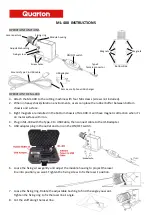
98
Microtuning Menu
The microtuning scale is selected on page 3 of
menu. This section
describes how to send and receive them.
After accessing the microtuning menu the following options are shown in the Right display:
Control
Parameter
Range
Description
Knob 1
Scale select
1–32
Selects the Microtuning scale location
2 (view only) Scale name
1–16 characters Define with third-party software (Scala, etc.)
Button 3
Receive Scale (action)
Puts Hydrasynth into Scale Receive mode
Button 4
Send Scale
(action)
Press to send selected scale sys-ex from
Hydrasynth Deluxe via MIDI / USB
Scale Select
Use this field to choose a location to receive
the new scale or send its scale via MIDI/USB.
Scale Name
The scale name is shown in this field. It cannot
be edited here. When creating your own
scales, be sure to set the scale name in the
third-party software before exporting it as
an MTS file (MIDI Tuning Standard). In Scala,
for example, the name is taken from the
Description section for the scale, not from the
file name. Note that Hydrasynth only uses the
first 16 characters in the name.
Receive Scale
Press Control button 3 to put the Hydrasynth
into sys-ex waiting mode. At this point,
you can send the sys-ex scale file from your
computer.
Send Scale
Press Control button 4 to send your scale via
sys-ex.
Keys: Page 3
Control Function
Settings
Description
1
Velocity
On, Fix 60 / 80 / 100 / 110 / 127
Select velocity response or fixed
value
2
Velocity Curve
Very Soft, Soft, Medium, Hard,
Very Hard, NeoSoft, Neo, NeoHard
Select velocity response
3
Aftertouch Delay
0-400 ms
(see description)
4
Aftertouch Fade
0-400 ms
(see description)
5
Aftertouch
On, Off
Toggle aftertouch sensitivity [1]
6
Aftertouch Curve
Softer through Harder (6 settings) Select aftertouch response
7
Aftertouch Offset
- 4 to + 4
(see description)
8
Aftertouch Release 0-400 ms
(see description)
[1] This will also disable or enable polyphonic aftertouch.
Velocity settings
To disable keyboard velocity sensitivity, select a fixed value (Fix 60, Fix 80, etc.). This only affects
local response and outgoing MIDI; incoming velocity response is unaffected.
Velocity Curve defines the amount of force needed to reach maximum velocity, and also the
curve from zero to maximum. The Very Soft through Very Hard curves vary from exponential to
















































